Picture Summary: PDC Course at Arbor Day Farm’s Lied Lodge – March 2012
- Bill Wilson
| Pictures by Milton Dixon and Bill Wilson — Narrative by Bill |

We delivered what we believe to be the first Permaculture Design Certificate (PDC) Course at this world renowned location. The Arbor Day Foundation is a leader in promoting the importance of trees for us as people and for the health of our planet. This is solid permaculture thinking.
 |
| The Arbor Day Foundation hosts their Arbor Day Farm, orchards, hazelnut research field, agri-forestry operation, and the beautiful Lied Lodge, all in Nebraska City, NE. |
 |
| Lied Lodge & Conference Center was designed to serve as a resource for the Arbor Day Foundation members, other conservation-related organizations (that’s us), teachers, and forestry professionals wishing to use a centrally located, high quality, and reasonably priced conference center. |
 |
| With its Adirondack styling of timbers and stone, Lied Lodge has won the American Hotel & Motel Association’s prestigious Enviro-Management Award for “developing a culture of integrating environmental management practices that improve everyday operations and the bottom line, while maintaining quality service and meeting guest expectations”. |
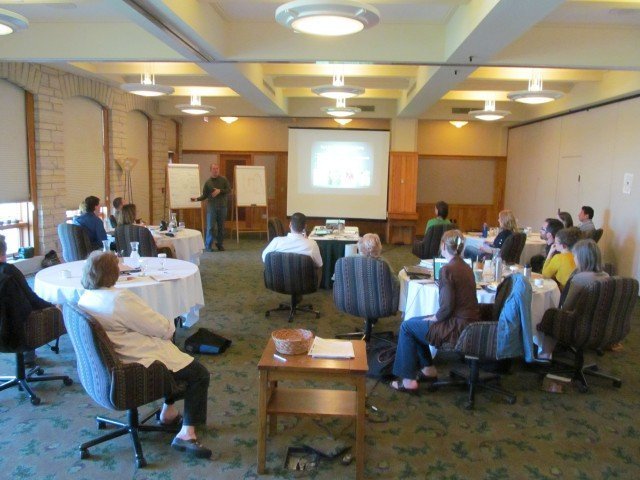 |
| The classroom was well equipped, very spacious, large windows looking out over the valley, and even had what they called “8-hour conference chairs” (padded, swiveled, rocked) which made the classroom time exceedingly comfortable and enjoyable. |
 |
| Milton Dixon (one of our key instructors) in control of the PowerPoint projector – A good look at the Lodge too. More pictures of the Lodge can be found at the bottom of the page. |
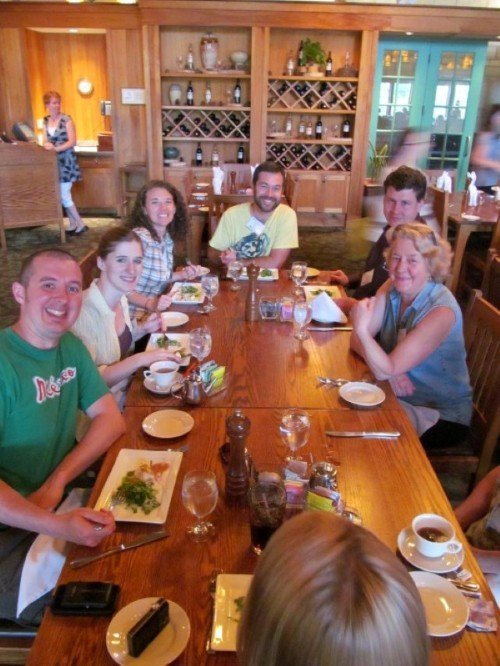 |
| We enjoyed three meals a day in this warm and spacious dining room. |
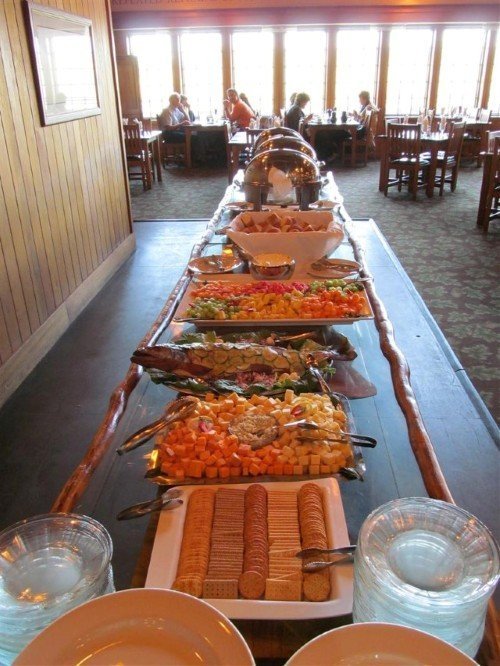 |
| Lied Lodge takes great pride in the fact that they have sourced much of the food they serve from area farmers. Most of it is organic and sustainably raised. |
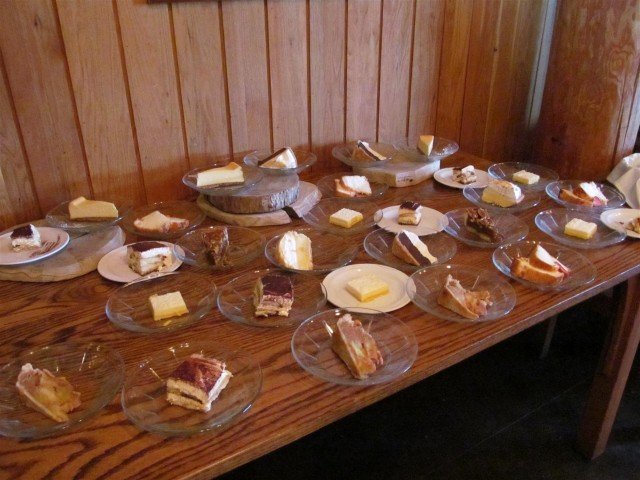 |
| We learned to not eat too much during the meals to save room for at least one desert. |
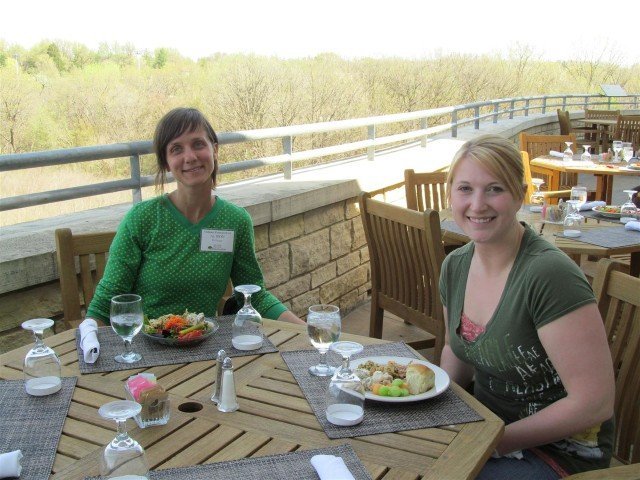 |
| The dining room extended outside to the deck… |
 |
| …which overlooked the valley to the original home-site of J. Sterling Morton, the originator of the Nationally celebrated Arbor Day. |
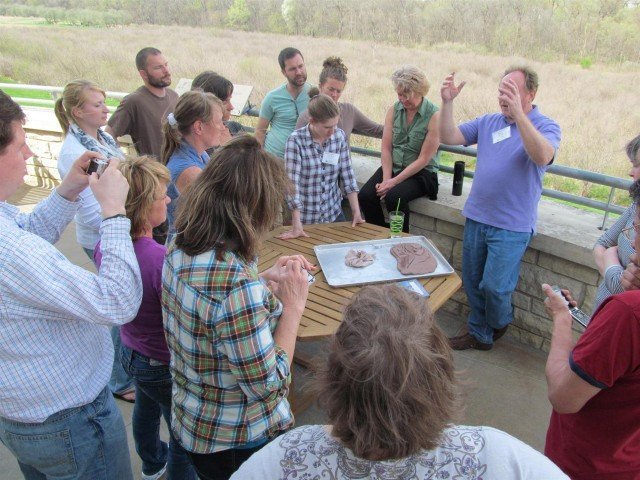 |
| We also used the deck as occasional classroom space. Even though it was March, we had near perfect weather on several of the days. |
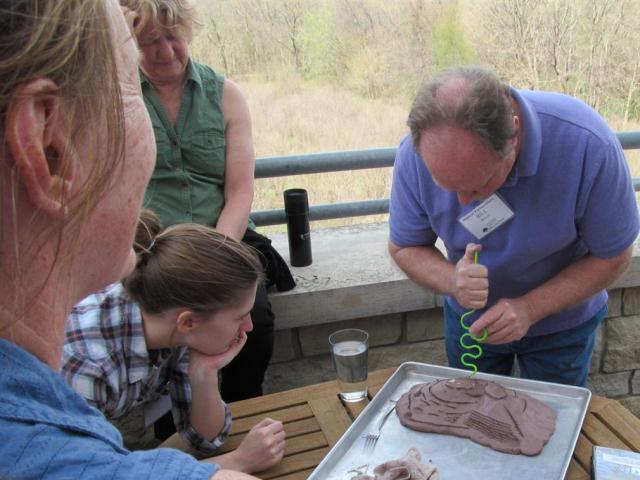 |
| One of the key design objectives in permaculture is to look for ways to hold rain water on the landscape. This allows it to soak into the ground, supporting more-rapid plant growth and to recharge the water tables. With the use of a clay model we are able do demonstrate many of these methods. |
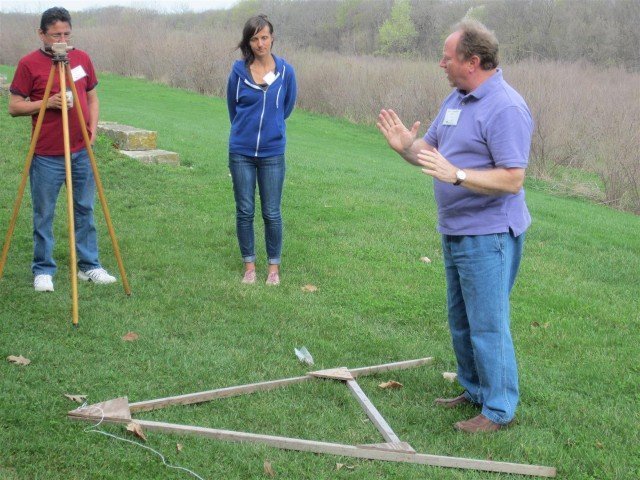 |
| After the demonstration we move on to the landscape and teach students several ways that they can measure for level. This is very important in pond and swale building. |
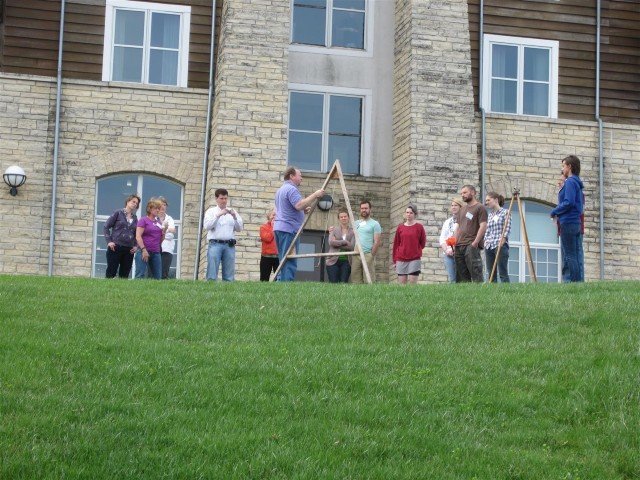 |
| The A-frame is an ancient tool that works incredibly well. |
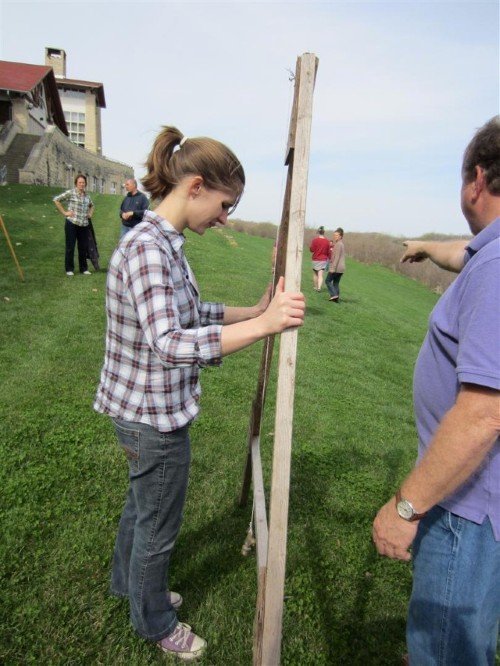 |
| We like each student to use it so that they feel confident in building and using their own when they need it. |
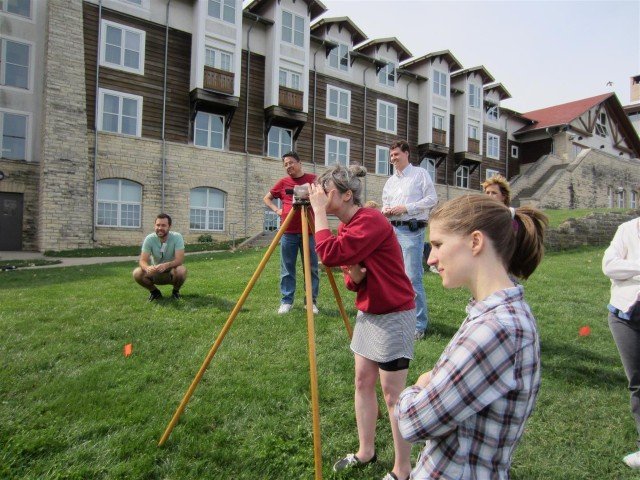 |
| A more modern tool that is used for the same purpose is a sight-level attached to a tripod, also called a transit. With it’s magnifying capabilities one can measure level at longer distances and much more quickly. They range in price from $100 for a simple used model to over $2,000 for a new one used by contractors and surveyors. |
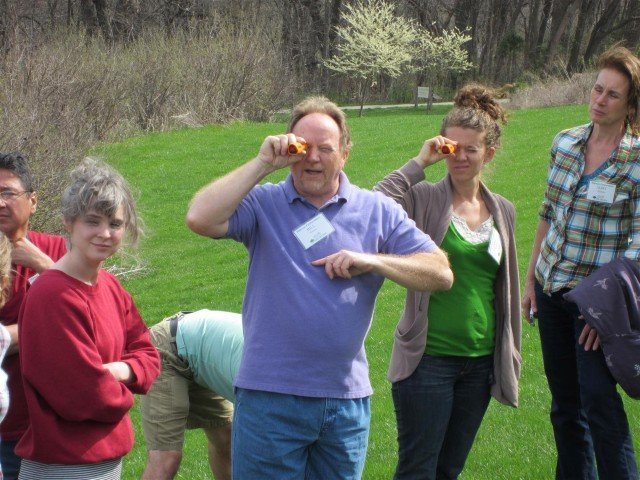 |
| Interestingly enough, for under $15, one can pick up a hand-held site level that will do the job for most applications. Students become experienced in how to use these as well. |
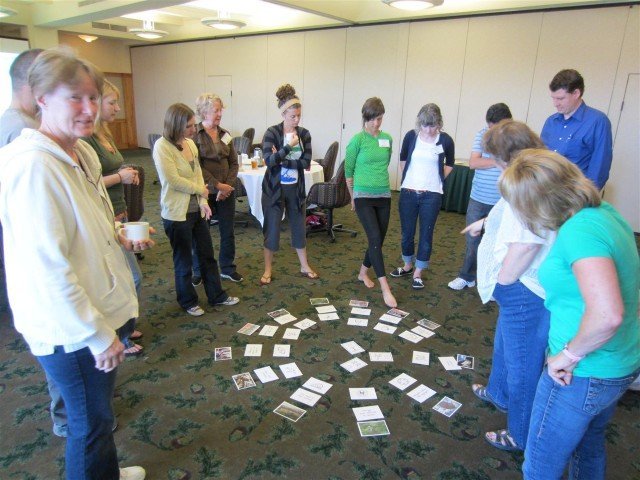 |
| Back in the classroom we continue to move through what what we feel is a brilliant curriculum. The work of Bill Mollison, David Holmgren and others is deeply inspiring, useful and hopeful. Here Becky is explaining an exercise in permaculture design principles. |
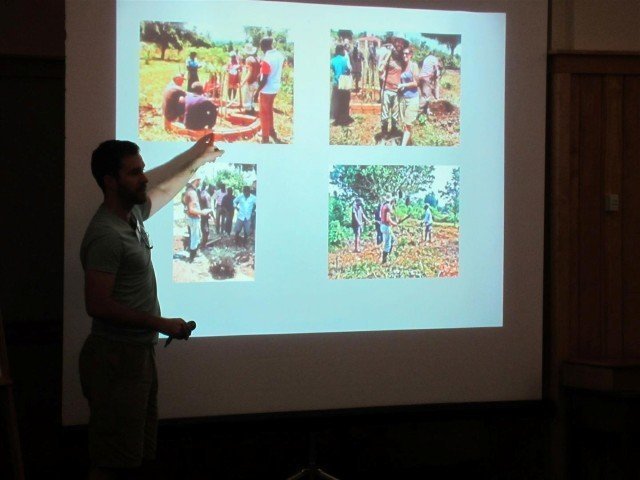 |
| Grant Shadden, a former PDC grad student of ours, came in for a day as a guest teacher to share about the work that he and his wife Paige have been undertaking in Africa. During Grant’s PDC course we created a basic permaculture design for this project. Paige was in this training earning her own PDC Certificate and has shared a bit about their project on our blog site. |
 |
| Many parts of the design course lend themselves to learning in the great outside classroom. Even this early in the spring, Milton is able to show students many wild edibles while exploring the soils and the layering of plants in the forest. |
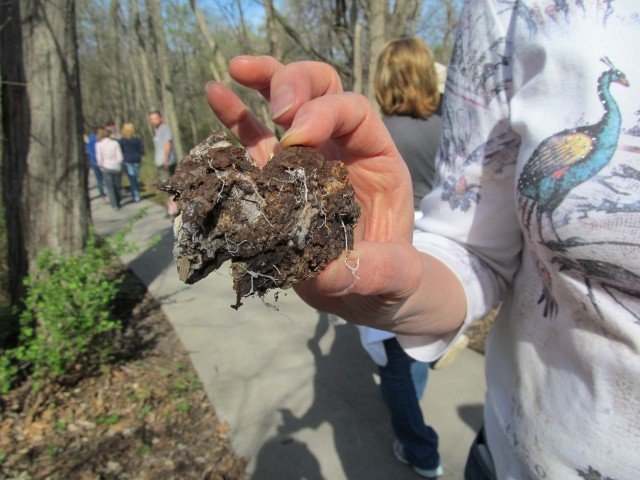 |
| The thin-white threads in the forest soil are called mycelium. They attach themselves to the roots of plants and trade the plants sugars for the nutrients that they pick up in the soil. They mycelium greatly increases the ability of the plant to access nutrients. It is truly a symbiotic relationship. |
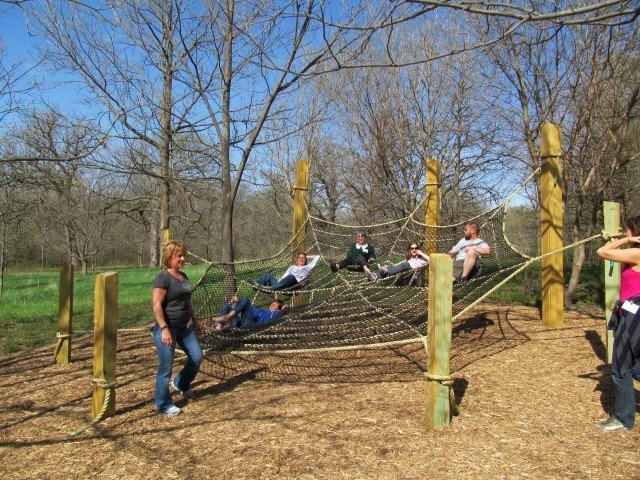 |
| As we make our way through the woods we come upon Arbor Day’s Tree Adventure Farm. We head inside and experience many of the educational features they have set up for children and adults alike. Some of our students could not resist the giant spider web for a quick break. |
 |
| Here is the deck of a three story tree house which gives visitors a sense of what it is like for the wildlife living in the trees. |
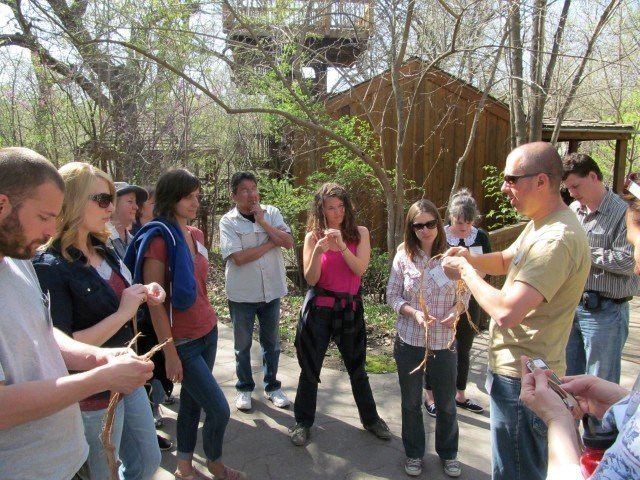 |
| Along the path, Milton finds a particular kind of bark that is suitable for making string and rope. An impromptu rope making session ensues. |
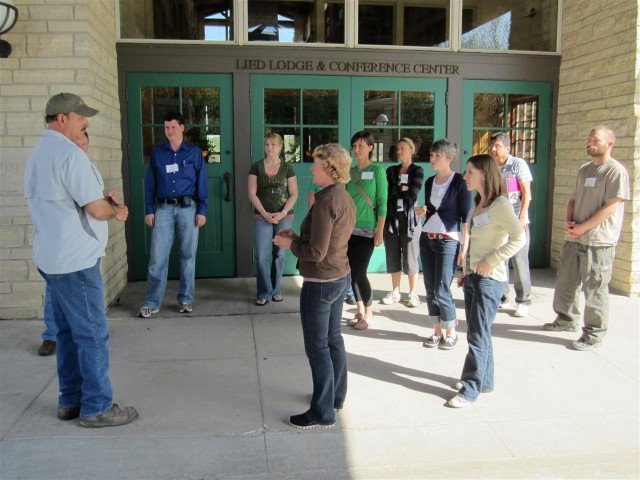 |
| Back at the Lodge we meet up with Arbor Day Forester Rod Edwards (left). Rod has been with the Lodge since they opened in 1993 and has overall responsibility for the grounds and several projects. |
 |
| One of these projects is the Hazelnut Research Field. Working in conjunction with several universities, the consortium hope to increase the viability of the hazelnut as a key crop for American farmers. Hazelnuts can produce about the same amount of protein and carbohydrates as convention crops (per acre) but as a perennial crop, the soil no longer needs to be plowed and exposed yearly. Soil erosion is a huge problem in conventional agriculture and the hazelnut could make a big difference. |
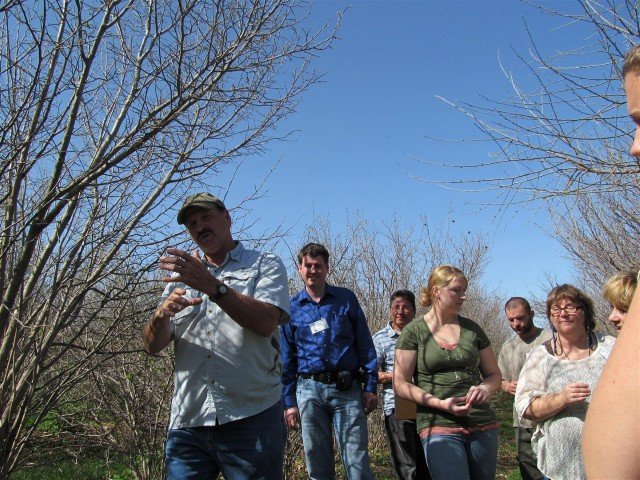 |
| Many of the original hazelnut bushes and the design of the field came from the assistance of Phil Rutter, founder of Badgersett in Iowa. Phil’s work in woody agriculture is truly amazing and noteworthy. Spending time on his website is worth every minute. |
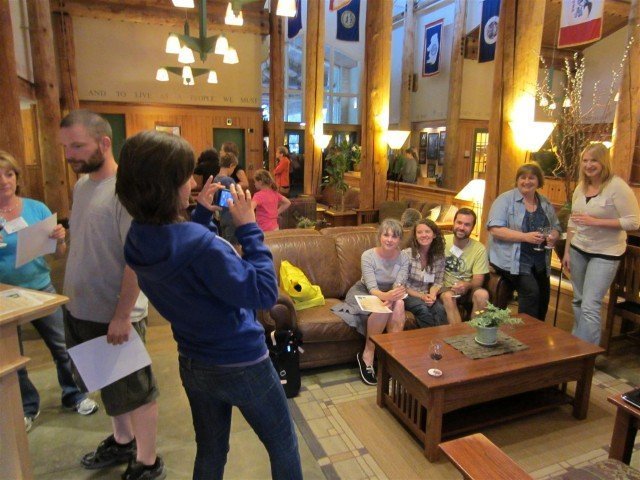 |
| Although we had course work each morning, afternoon and evening, we did take some time to relax and enjoy the lounges and facilities (like the Olympic sized swimming pool). |
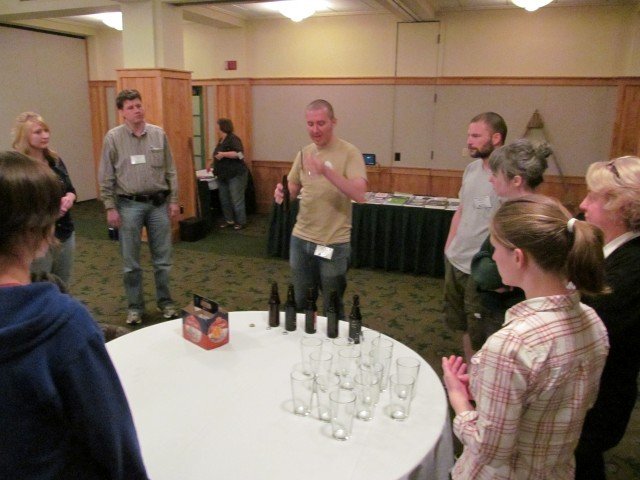 |
| In one of our evening classes, Milton took some time to talk about the importance, ease and benefits of fermenting foods. Here he shares some samples of several types of mead (wines made with honey) he personally made. |
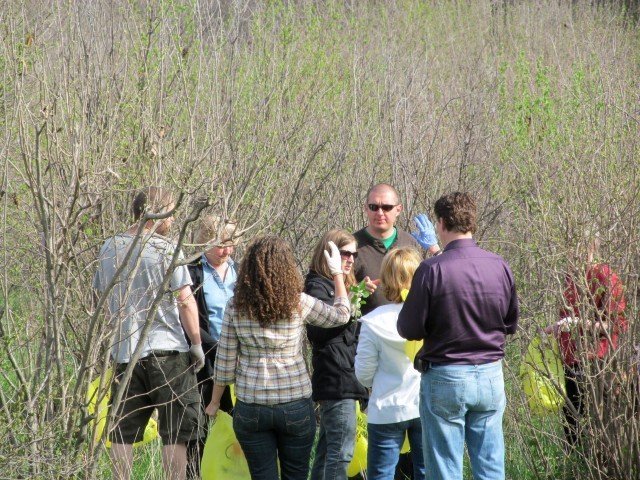 |
| As we worked our way through the grounds we discovered more and more edible-wild foods. Milton and students headed out on a wild-food scavenger hunt. |
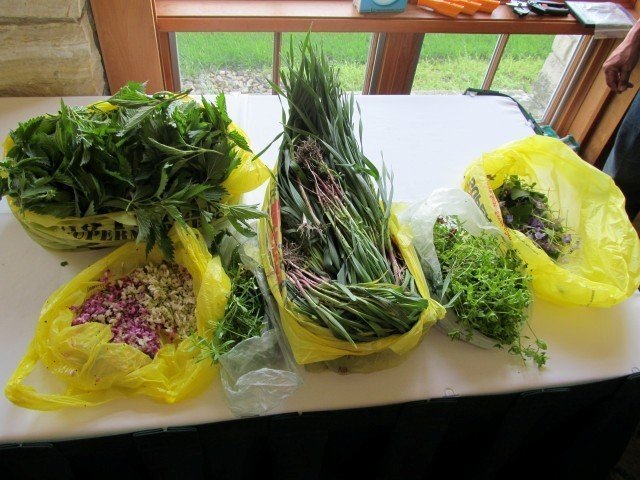 |
| Texture, color, flavor… and all of it edible. We ended up harvesting (L-R) red bud flowers, nettles, cleavers bedstraw (the small bag), wild leeks (ramps), chickweed and violets. |
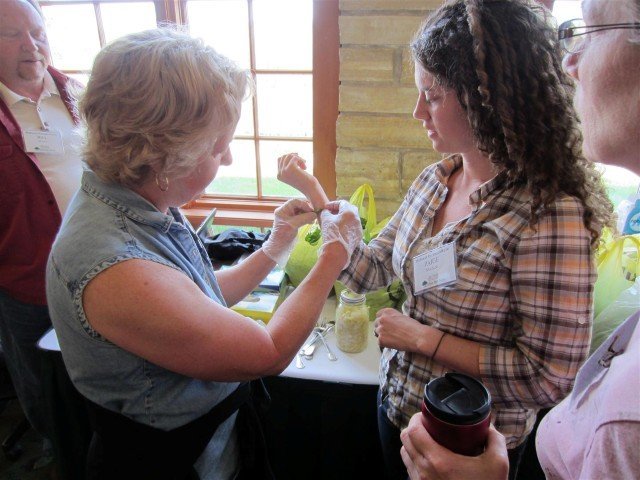 |
| One plant growing in abundance was stinging nettles. Although complete harmless and delicious after cooking, touching them with one’s bare skin causes a stinging sensation. Fortunately, one of our students, Christine, has experience with this and knew of a quick remedy. She simply picked up the stalk of the nettle plant, broke it and frayed the ends which caused the secretion of a small amount of liquid. Rubbed on to the affected area of ones skin completely took away the stinging sensation. |
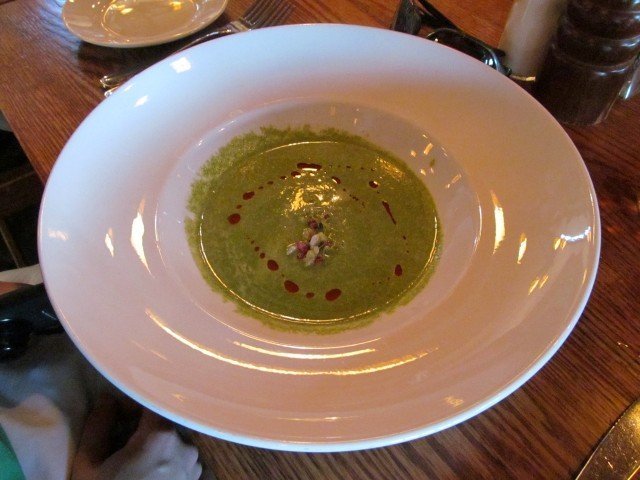 |
| Fortunately for us, we had a chef in our midst, so that night we dined on nettle and potato soup with smoked paprika oil and candied redbud flowers… |
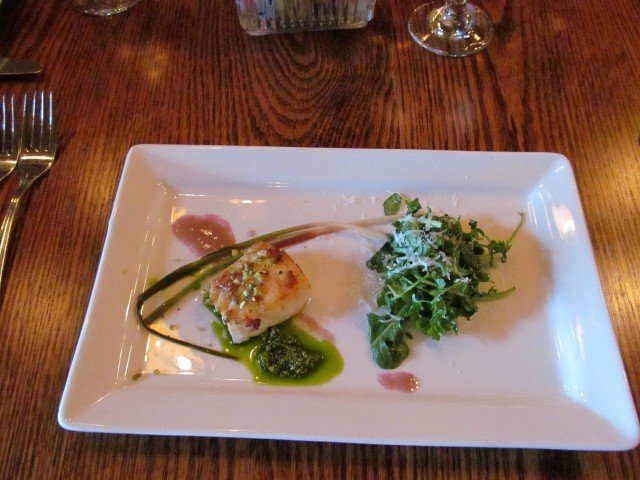 |
| …along with Alaska dayboat halibut, chickweed salad with violet vinaigrette and pickled onions. |
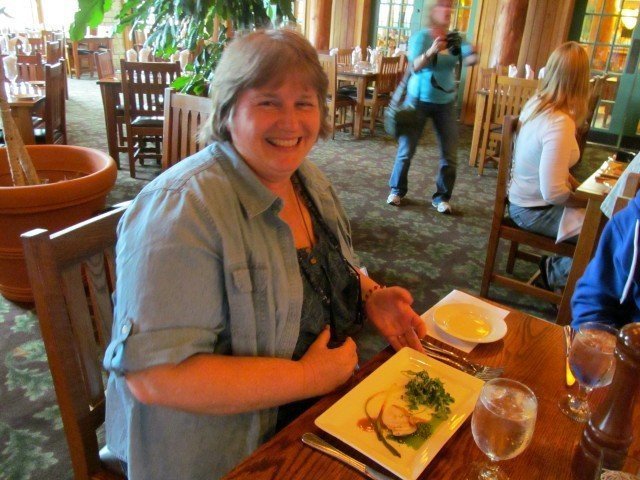 |
| Becky was so delighted with the presentation of it that she was reluctant to disturb it. |
 |
| Christine (and others) licked her bowl clean. The flavors were fantastic. |
 |
| As the curriculum sinks in, our students then began to what they’ve learned and their own experience into permaculture design. After getting to know the kitchen crew, we learned that they had the desire to start growing some of their own herbs and common vegetables on the grounds of Arbor Day Farm for their menu. They also wanted to add an educational component for the public. We decided to tackle this as the final design project for the training. |
 |
| We broke up into groups, each tackling a different aspect of the design. |
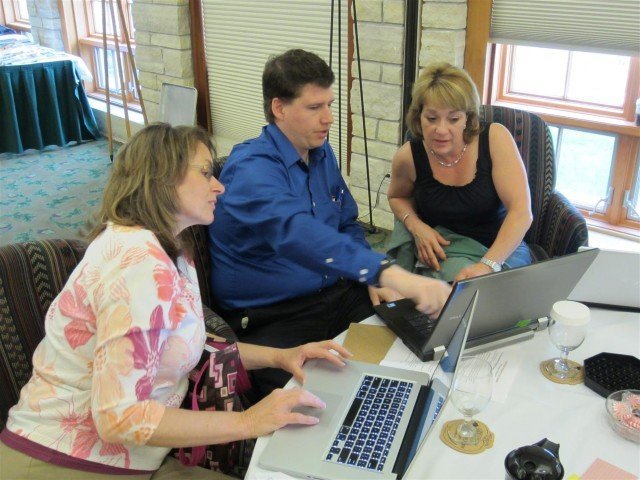 |
| The design work required some research as well as brainstorming with each other. Important to understand about permaculture design is that there is very rarely just one way to design something. There are usually multiple approaches in permaculture to create a beautiful, sustainable and productive system. |
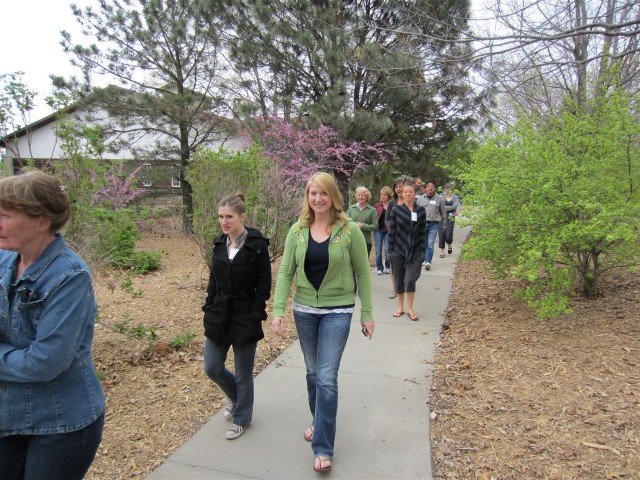 |
| Even in the midst of our design work we headed outside to clear our minds and continue to explore permaculture possibilities and applications. |
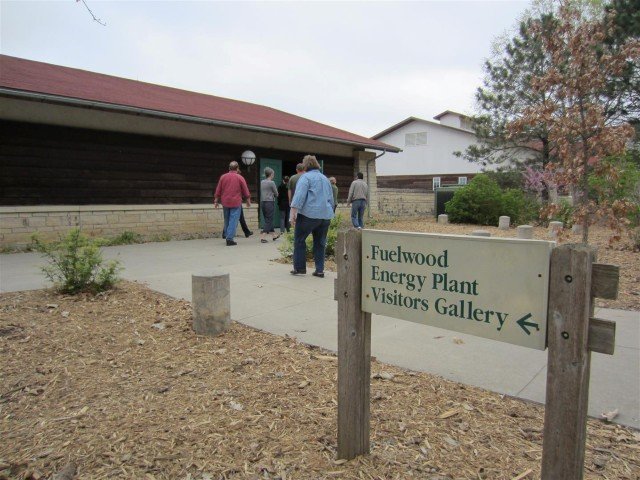 |
| At the Lodge, they use waste wood or wood chips not only to fuel their boilers to heat the buildings and water for everyday use, they also use the excess heat to cool the building in the summer. Click Here to learn More. |
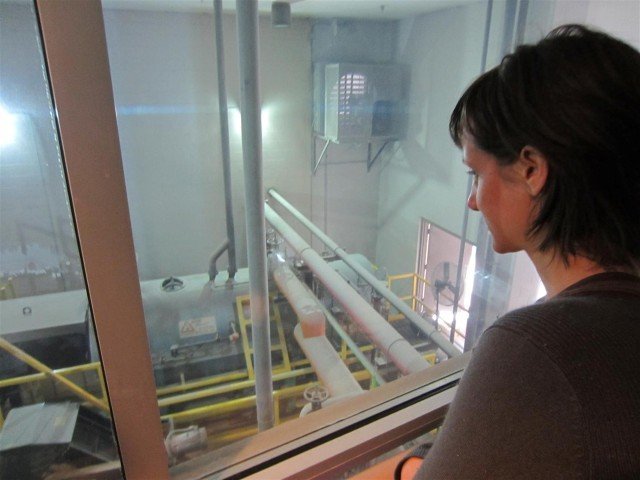 |
| From the visitors gallery we could see the boiler plant in operation. |
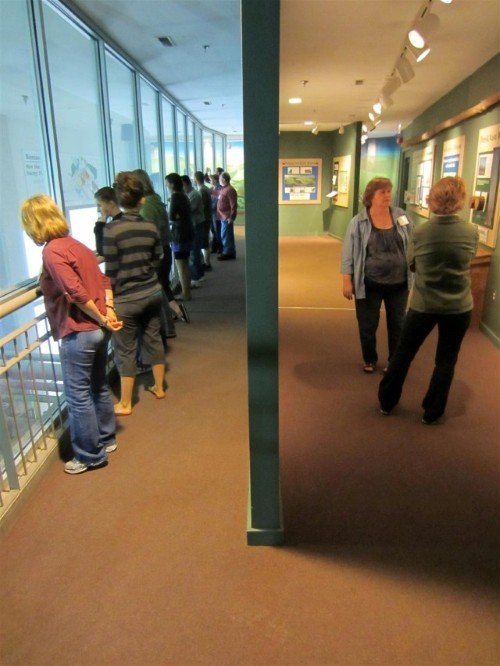 |
| On the other side of the viewing gallery is an educational corridor that explains many aspects of the benefits of woody agriculture. |
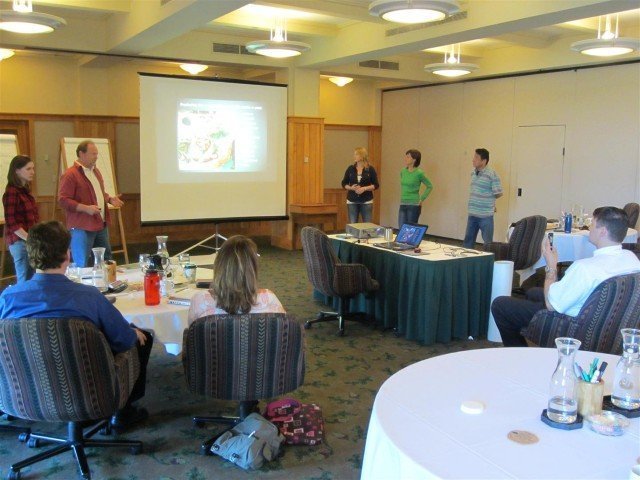 |
| On our final day of class, the head Chef at Lied Lodge, Mathew Taylor, stopped by and students shared their permaculture design work with him. Matt emphasized to us, the importance of the mission of the Arbor Day Foundation, ” We inspire people to plant, nurture, and celebrate trees ” and recognized that Permaculture supports these conservation tenets. |
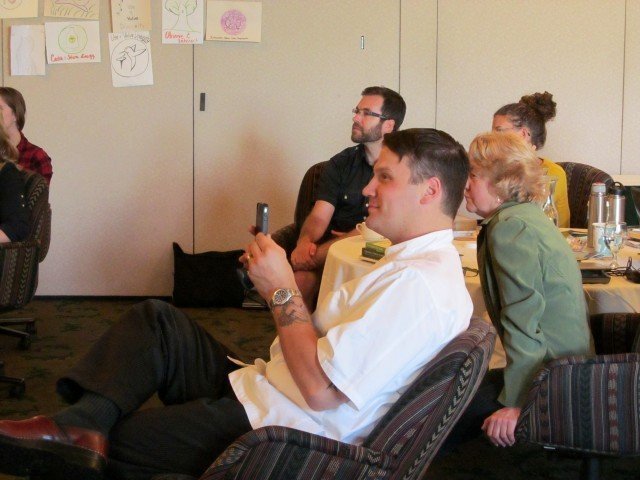 |
|
Fortunately he had his cell phone with him and was able to video record the entire presentation. In his own words: “This is utterly amazing. I am blown away. I can hardly wait to get started on much of this.” |
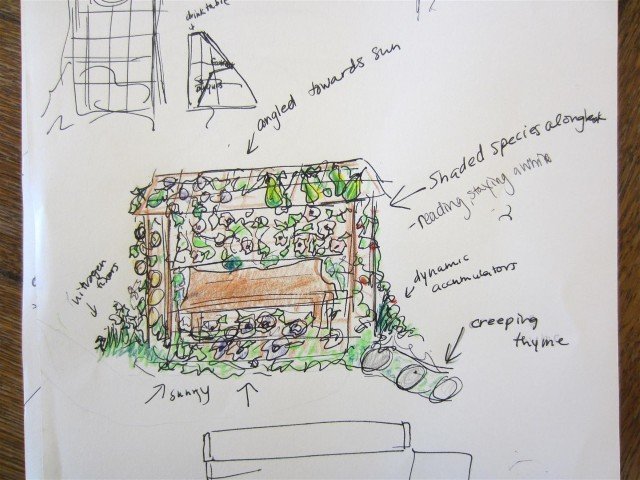 |
| With simple sketches and pictures (shared via PowerPoint) we were able to integrate Matthew’s visions into a myriad of compatible components that will not only serve his needs, but could also advance the work of the Arbor Day Foundation. We are talking with Matthew now on a possible second PDC course at Lied Lodge early next year. We will keep you posted about this on our website and in our newsletters. This next course should be every bit as powerful as this one. |
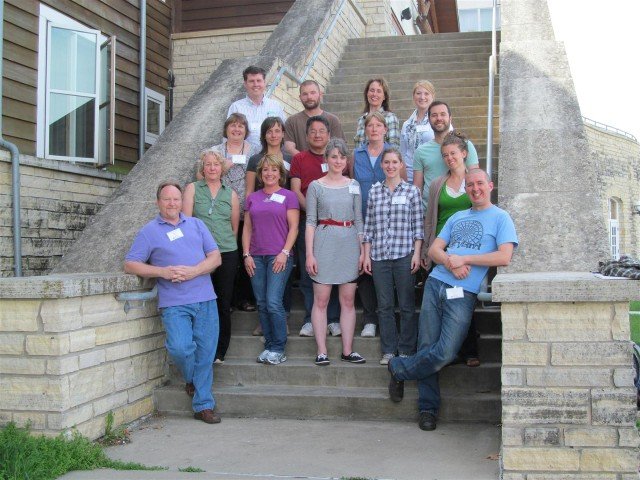 |
| Midwest Permaculture Design Course Graduates and Teachers Lied Lodge – March 2012 |
A Few More Pictures of Lied Lodge |
| Main Entrance |
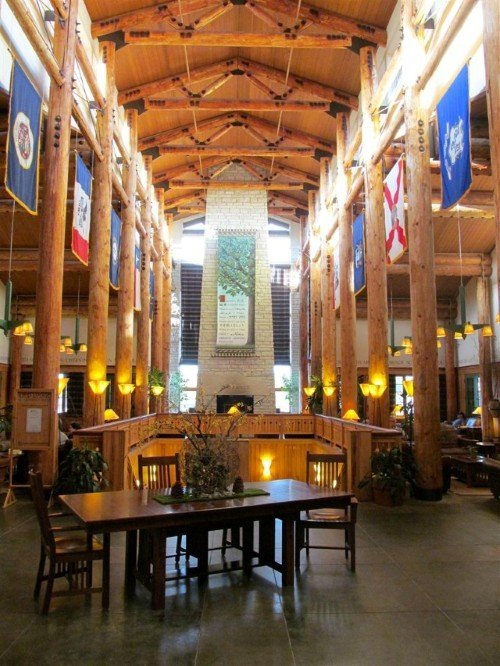 |
| The Main Hall |
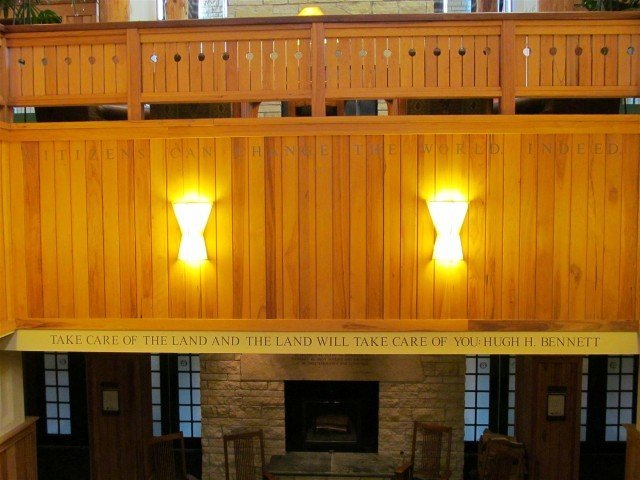 |
| Looking down the stairs to the conference area. There were many great quotes, such as this one by Hugh H. Bennett, all over the hall. |
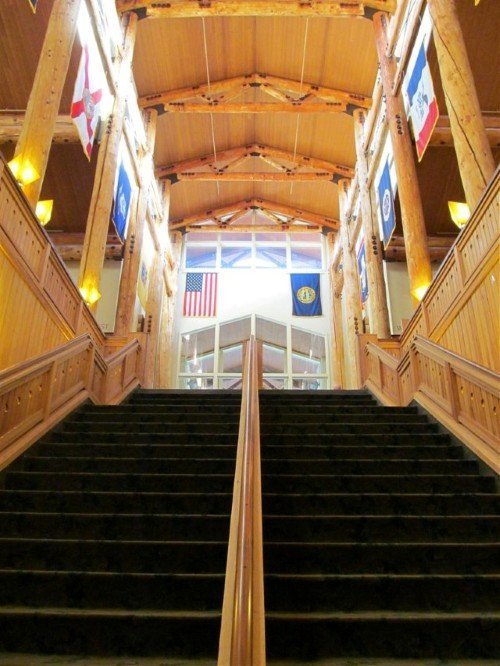 |
| At the bottom of the stairs looking back up. |
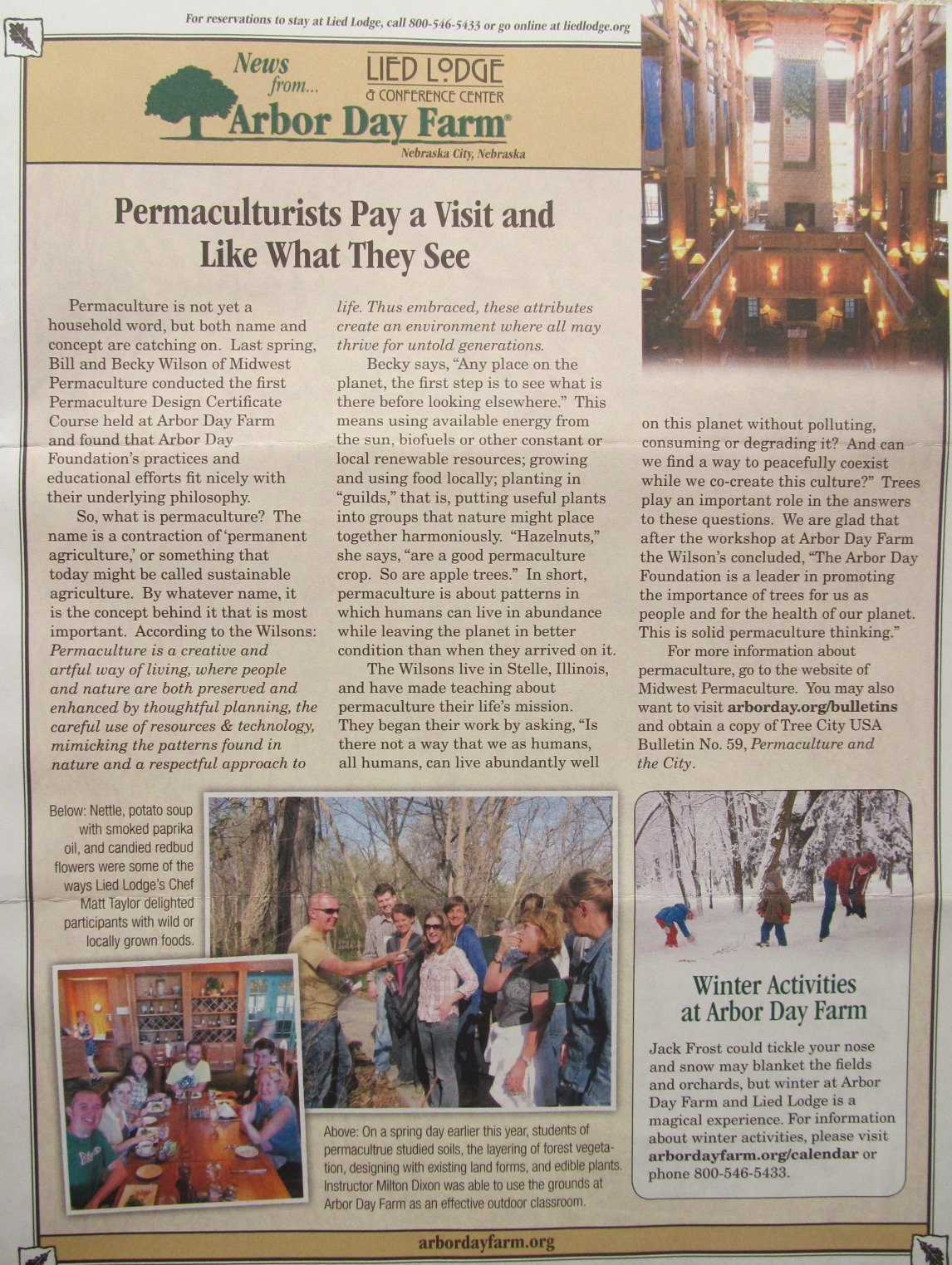 |
| Later in the year this course was featured in the Arbor Day Farm News Letter |
|
I hope you have enjoyed viewing these pictures. As graduates of a Midwest Permaculture PDC Course, these students now have access to our continually updated ‘Foundations of Permaculture’ webinar series and will be invited to occasional reunions we host for all PDC grads. They may also audit any future PDC training hosted by Midwest Permaculture for 50% off. Our goal is to support our students long after a training should they want or need it. Bill Wilson – Midwest Permaculture |

4 thoughts on “Picture Summary: PDC Course at Arbor Day Farm’s Lied Lodge – March 2012”
Haven’t seen the lodge in years. Good to see my old boss Rod Edwards again! Loved working there doing landscape maintenance. Permaculture is a fascinating subject! Although I haven’t taken a course yet, I am striving to implement permaculture techniques on my own acreage and in the gardens.
Wonderful! I work at Lied Lodge, and it was such a joy to host your group back in March. The photos and descriptions you’ve shared here are phenomenal! Well done — keep up the good work. Thank you! ~Amy~
Man this just brings me back to memories of my PDC. Looked like an amazing time!!! and great photos!!
You bet Ernest. Your course was a wonderful week as well. These trainings attract such great people.